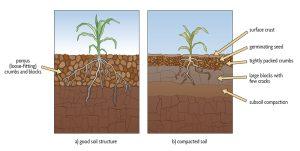8 Minute Read
You’re looking at lawns seemingly doomed by compacted soils. The turf is struggling to grow. Weeds are taking over. You don’t know where to start. We’re here to simplify lawn care and help you integrate organic turf care seamlessly. To address soil compaction: aerate, over seed and feed your soil to increase calcium levels.
Soil Health in Lawns

Source: “Building Soils for Better Crops”, sare.org
When it comes to Organic Turf Care, everything starts with the soil. Healthy turf stands grow on healthy soils. In light of this, remember that healthy soils have a balanced chemistry, consist of diverse biology, and are well structured.
Compacted soils are mostly caused by high foot traffic – pedestrian or athletic – and cause a host of problems for turf grass. Primarily, a lack of porosity for root growth and water penetration create weak turf stands that can’t compete with weeds, diseases and insects. The fibrous roots of grass grow in air pockets within the soil. Therefore, as soil conditions worsen, these air pockets disappear and create an environment suitable for broadleaf weeds with long, central tapped roots like dandelions or rapid growth opportunists like plantain. On the contrary, diverse turf stands, that are composed of many different turf species, stand the best chance of maintaining a tall canopy throughout the growing season. Moreover, a tall canopy of turf shades out undesired weeds.
Practical Approach: Cultural Practices to Reduce Soil Compaction in Your Lawn
Core aeration is the most effective method of mechanically alleviating soil compaction on sports fields and lawns. Thus, a good rule of thumb for core aeration timing is when turf stands are growing vigorously – late spring, late summer and early fall. Here in New England, PJC Organic recommends an absolute minimum of one aeration and over seed per growing season and we encourage that timeline around August 15th. In fact, a late summer over seed gives your seed the best chance of germination and establishment before the consistent frosts of fall and winter.
We feel strongly that every single time you are coring the soil, you should be dropping seed and applying soil amendments to make the biggest impact on your soil conditions. Remember, turf grass is regularly mowed so it doesn’t disperse its own seed like it would in a meadow. Therefore, it’s critical to consistently be introducing new plants culturally. Don’t forget to irrigate properly and to follow our 1-2-3-2-1 Watering Method—especially after over seeding.
Proven Products: Organic Soil Amendments for Your Turf
Look to increase soil calcium levels to address compaction through soil chemistry. Calcium cations are structurally sound and create better soil porosity, cation exchange capacity, and nutrient bioavailability. Additionally, many beneficial organisms and nitrifying bacteria utilize calcium cations as structural elements in their body composition – creating a more robust terrestrial biosphere. Lastly, calcium is a turfgrass macronutrient essential to cell wall structure and membrane permeability. This allows the turf to move nitrogen and sugar compounds throughout the plant.
When your pH is low, be sure to utilize lime (CaCO3 – little 3) to bring it into optimal range 6.5-7.0. If you have a balanced soil pH (lucky you) – be sure to apply Gypsum (CaS04.2:H20). A good addition to any program is timely applications of PJC ProHealthy Turf Boost+S3 – comprised of gypsum, humates and chelated iron. This addition of calcium and humic acids chelates desired metals (Ca2+, Mg2+ and Fe2+) for the plant to uptake and increase the Cation Exchange Capacity of the soil. Lastly, turf grass and soils need a constant replenishment of calcium. So, take advantage of that cored soil and get those essential calcium cations into the root profile!
For the Next Generation: Be Consistent
We’ve covered why you should aerate, over seed and feed your soil to address compaction in your lawn. Now, consistency is key. Productive impacts on the soil ecosystem takes time and effort. Adjusting pH with a high efficiency lime product takes about 6 months after each application. Additionally, increasing organic matter by 3% over a ten-year span is considered a great success. Calcium availability is tantamount to nitrogen and potassium levels. In any case, at PJC, we recommend taking soil samples every 3 years to effectively evaluate changes in soil conditions. Be patient for results – long term efforts will pay long term dividends.








